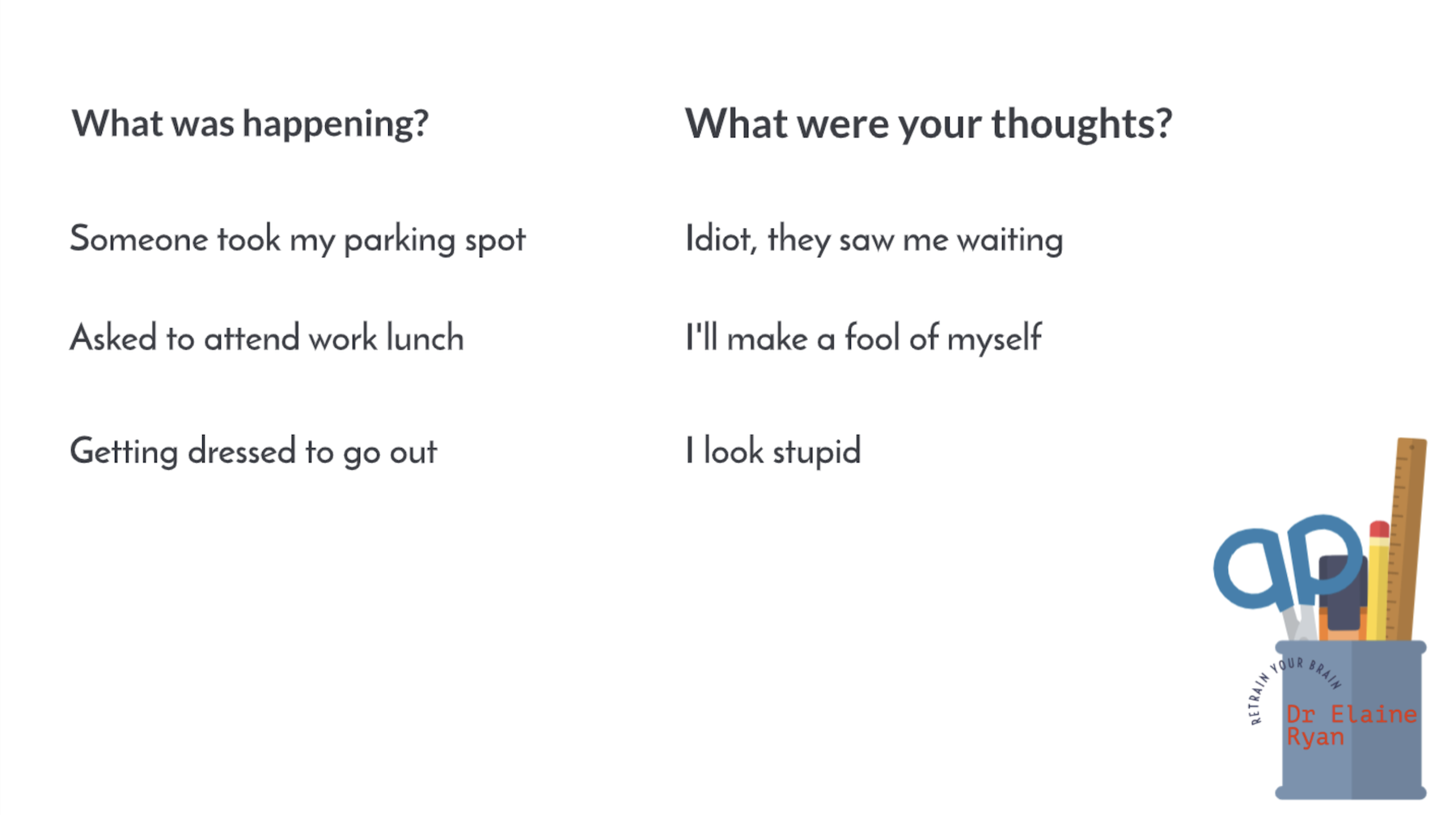This article is part of a series of articles called working with anxiety.
This article will show you how to work with the cognitive aspect of anxiety; in other words, we shall be working with your thought processes. We are going to use a model of therapy called cognitive behavioural therapy. To get the best out of this article, I think it would be helpful to explain what cognitions are and summarize how we use cognitive behavioural therapy to work with cognitions.
Retrain Your Brain®

Dr Ryan’s online self-help course for anxiety
What are cognitions?
When I talk about cognition, I refer to a set of mental processes. These processes are all your
- thought processes
- how you remember things
- what judgements you make
- belief systems
You must understand cognition and the relevance and impact on anxiety as two people could experience the same situation, but only one view it as anxiety creating.
These mental processes (your cognitions) affect how you are feeling.
When things do not go favourably for you, what you get upset about is primarily determined by how you think about the situation.
Generally, it is not the situation that makes you feel anxious, distressed, happy or sad; your mood depends on how you think about the situation, how you remember what happened, in other words, your cognitions.
Your cognition determines how you feel about the situation.
Your mental processes can also be responsible for how you behave in the situation.
Let’s say you get anxious in social situations, and without warning, you are asked to stand up and give a talk in front of your colleagues.
For most people, this can cause stress as you are out of your comfort zone. Still, for others, particularly those with social anxiety, your cognitive processes can affect how you feel, whether or not you can give the talk and give you physical symptoms of stress in your body.
In this example, the cognitive processes at work could be
- remembering previous times when you struggled during public speaking and
- remembering the last time you were in the spotlight and did not like it.
It is how you remember situations that can cause your problems now and how you judge yourself in this situation.
In other words, how you’re talking to yourself inside your head may be less than encouraging. You might think that you are making a fool of yourself. You might believe that others are judging you harshly.
These two examples of cognitive processes at work, i.e. remembering previous experiences and judging yourself, will affect what you feel now.
Your cognitions and what you feel in your body can determine your behaviour. If you are shaking and feeling like a fool, you might excuse why you cannot talk.
It is not the talk that is the problem. Your mental processes (your cognitions) is the problem. This is why it is crucial that you not only understand the power of your cognitive processes, but you can identify them and work with them so that they help you as opposed to hinder you in situations.
I am choosing to introduce you to the cognitive behavioural therapy model to help you identify faulty cognitions and show you how to work with them to reduce your experience of anxiety.
It is essential to note the behavioural aspect of cognitive behavioural therapy. It is not just looking at and working with thoughts but also working with your behaviours. Behaviours are the things you do and the things you do not do. But for now, we will work only with your conditions before moving on to your behaviours.
Summary of behavioural therapy
The cognitive aspect of CBT helps you identify the mental processes, thoughts, beliefs and attitudes that are causing you problems. The model teaches you how to change or reframe thoughts processes into more rational, realistic ones.
The behavioural part of CBT helps you see how you could be harming yourself. For example, you could identify behaviours that negatively affect you, such as expecting you to be perfect in your actions.
How to start working with your cognitions.
It’s important to note that in CBT, cognition is not only about yourself but also includes your thoughts and beliefs about others.
Frequently the belief systems held about others are missed out or overlooked by some therapists, and they are a crucial aspect of your mental life.
Let’s make a start.
Any time you notice that you are getting anxious, stop and ask yourself what is happening with your thought processes and then write it down.
For example, if you get upset as someone got in a parking space before you did, your thoughts might be, “Idiot, they saw me here first.”
Your sheet might look something like this.

That’s it. Taking time to monitor your cognitions is the first step in working with anxiety.
In the next part of this series, I shall be taking a deeper look at your cognitions.
